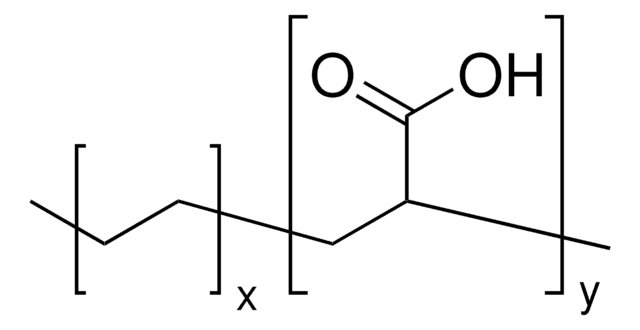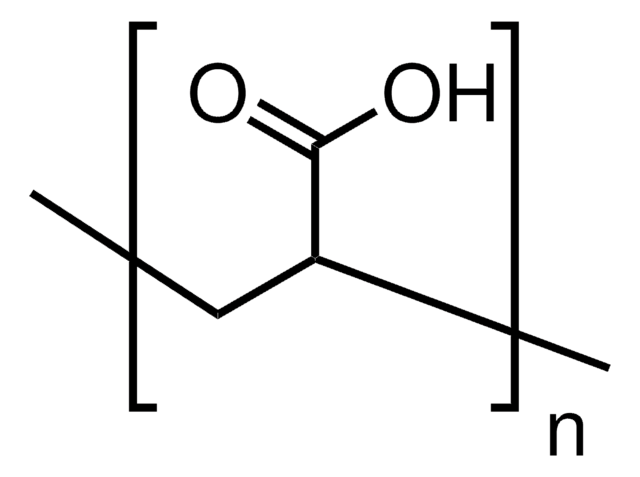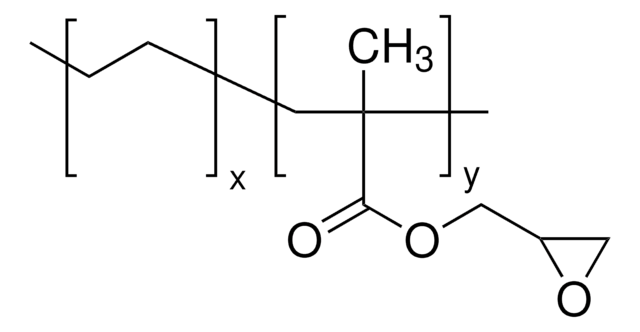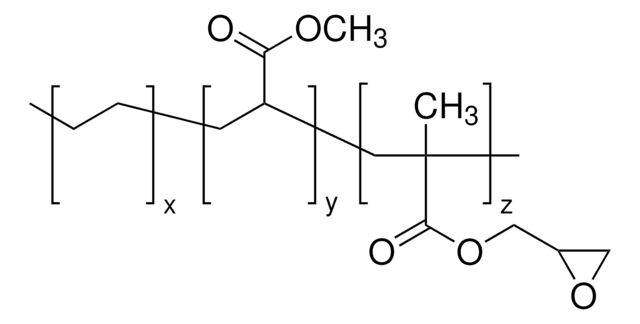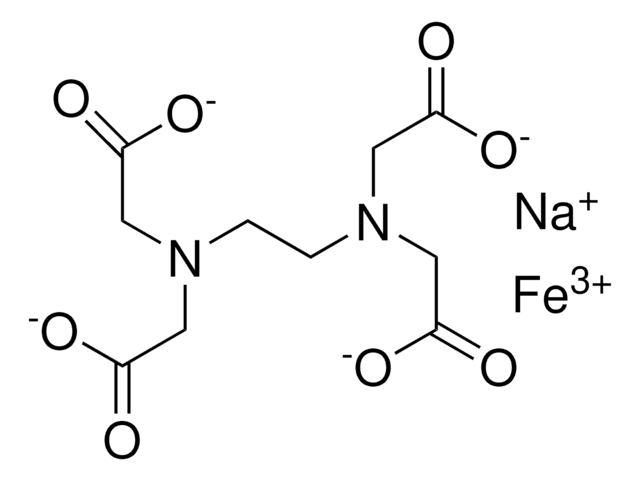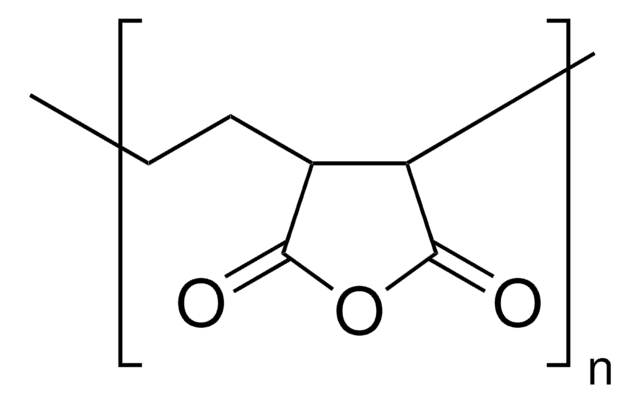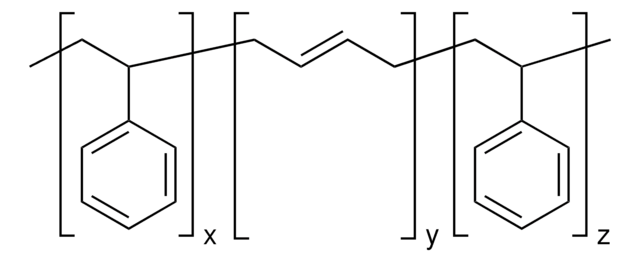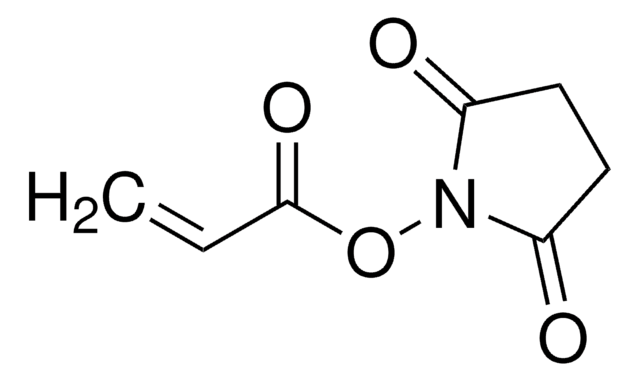448672
Poly(ethylene-co-acrylic acid)
acrylic acid 15 wt. %
Iniciar sesiónpara Ver la Fijación de precios por contrato y de la organización
About This Item
Fórmula lineal:
(CH2CH2)x[CH2CH(CO2H)]y
Número de CAS:
MDL number:
UNSPSC Code:
12162002
PubChem Substance ID:
NACRES:
NA.23
Productos recomendados
composition
acrylic acid, 15 wt. %
hardness
≤15 dmm (ASTM D 5, 25 °C)
viscosity
600 cP(140 °C, Brookfield)(lit.)
acid number
112‑130 mg KOH/g
transition temp
Tm (DSC) 87 °C (at peak)
density
0.93 g/mL at 25 °C
SMILES string
C=C.OC(=O)C=C
InChI
1S/C3H4O2.C2H4/c1-2-3(4)5;1-2/h2H,1H2,(H,4,5);1-2H2
InChI key
QHZOMAXECYYXGP-UHFFFAOYSA-N
¿Está buscando productos similares? Visita Guía de comparación de productos
Application
Processing and performance additive. Promotes crystallization of PET. Assists dispersion of additives in plastics.
Features and Benefits
Forms reversible ionic clusters (crosslinks). Promotes adhesion to various substrates, tougher, more chemically resistant and more transparent than parent acid copolymer.
Elija entre una de las versiones más recientes:
¿Ya tiene este producto?
Encuentre la documentación para los productos que ha comprado recientemente en la Biblioteca de documentos.
Newton C Fawcett et al.
Langmuir : the ACS journal of surfaces and colloids, 20(16), 6651-6657 (2004-07-28)
Yoshimoto et al. [Anal. Chem. 2002, 74, 4306-4309] reported that a quartz crystal microbalance or QCM changed its response to sucrose solutions according to its angle of immersion. The effect was tentatively attributed to gravity-caused stress on the viscous interface
Christoph Meyer et al.
Analytical and bioanalytical chemistry, 382(3), 679-690 (2004-08-04)
Three poly(ethylene-co-acrylic) acid copolymers (-CH(2)CH(2)-)(x)[CH(2)CH(CO(2)H)-](y) with different chain lengths and mass fractions of acrylic acid were covalently immobilized as stationary phases on silica via two variants of spacer molecules (3-aminopropyltriethoxysilane and 3-glycidoxypropyltrimethoxysilane). Different mobilities of the alkyl chains in the
Siri Schauff et al.
Analytical chemistry, 79(21), 8323-8326 (2007-10-09)
The separation process in reversed-phase high-performance liquid chromatography employing C18 phases is mainly due to hydrophobic interactions. The separation of tocopherol isomers, exhibited by the C30 phases, however, is additionally driven by shape selectivity. This phenomenon is investigated by suspended-state
Xiaodi Su et al.
Journal of colloid and interface science, 287(1), 35-42 (2005-05-26)
In this study, we use the quartz crystal microbalance with dissipation monitoring (QCM-D) to study the immobilization of the enzyme horseradish peroxidase (HRP) on poly(ethylene-co-acrylic acid) (PEAA) films. The surface polarity of spin-coated PEAA films was varied by heat treatments
Ning Luo et al.
Colloids and surfaces. B, Biointerfaces, 50(2), 89-96 (2006-06-06)
Poly(ethylene-co-acrylic acid) (EAA) films were reacted with glycine, 12-aminododecanoic acid, aspartic acid, 5-aminoisophthalic acid, ethanolamine, diethylamine, dimethylamine, N-isopropylamine, and dimethylaminoethyleneamine to prepare EAA films with negatively charged, non-charged, hydrophilic, and hydrophobic functionalities. Attenuated total reflectance Fourier transform infrared spectroscopy, differential
Nuestro equipo de científicos tiene experiencia en todas las áreas de investigación: Ciencias de la vida, Ciencia de los materiales, Síntesis química, Cromatografía, Analítica y muchas otras.
Póngase en contacto con el Servicio técnico